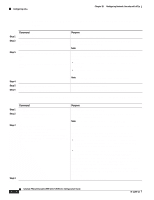Cisco 2950 Software Configuration Guide - Page 549
Applying Time Ranges to ACLs, Step 5
 |
UPC - 746320454504
View all Cisco 2950 manuals
Add to My Manuals
Save this manual to your list of manuals |
Page 549 highlights
Chapter 29 Configuring Network Security with ACLs Configuring ACLs Step 5 Step 6 Command show access-lists [number | name] copy running-config startup-config Purpose Show the access list configuration. (Optional) Save your entries in the configuration file. When making the standard and extended ACL, remember that, by default, the end of the ACL contains an implicit deny statement for everything if it did not find a match before reaching the end. For standard ACLs, if you omit the mask from an associated IP host address access list specification, 0.0.0.0 is assumed to be the mask. After you create an ACL, any additions are placed at the end of the list. You cannot selectively add ACEs to a specific ACL. However, you can use no permit and no deny commands to remove ACEs from a named ACL. This example shows how you can delete individual ACEs from a named ACL: Switch(config)# ip access-list extended border-list Switch(config-ext-nacl)# no permit ip host 10.1.1.3 any Being able to selectively remove lines from a named ACL is one reason you might use named ACLs instead of numbered ACLs. After creating an ACL, you must apply it to a line or interface, as described in the "Applying ACLs to Terminal Lines or Physical Interfaces" section on page 29-19. Applying Time Ranges to ACLs You can implement extended ACLs based on the time of day and week by using the time-range global configuration command. First, define the name and times of the day and week of the time range, and then reference the time range by name in an ACL to apply restrictions to the access list. You can use the time range to define when the permit or deny statements in the ACL are in effect. The time-range keyword and argument are referenced in the named and numbered extended ACL task tables in the "Creating Standard and Extended IP ACLs" section on page 29-7, and the "Creating Named Standard and Extended ACLs" section on page 29-13. These are some of the many benefits of using time ranges: • You have more control over permitting or denying a user access to resources, such as an application (identified by an IP address mask pair and a port number). • You can control logging messages. ACL entries can log traffic at certain times of the day, but not constantly. Therefore, you can simply deny access without having to analyze many logs generated during peak hours. Note The time range relies on the switch system clock. Therefore, you need a reliable clock source. We recommend that you use Network Time Protocol (NTP) to synchronize the switch clock. For more information, see the "Managing the System Time and Date" section on page 8-1. Beginning in privileged EXEC mode, follow these steps to configure a time-range parameter for an ACL: Step 1 Step 2 Command configure terminal time-range time-range-name Purpose Enter global configuration mode. Identify the time-range by a meaningful name (for example, workhours), and enter time-range configuration mode. The name cannot contain a space or quotation mark and must begin with a letter. 78-11380-10 Catalyst 2950 and Catalyst 2955 Switch Software Configuration Guide 29-15















